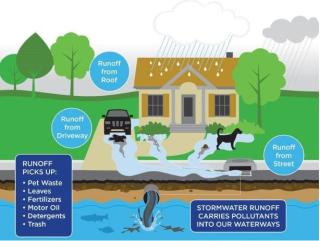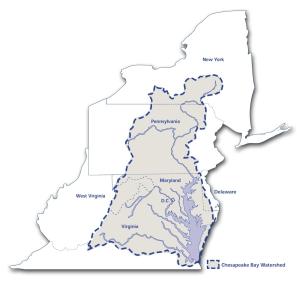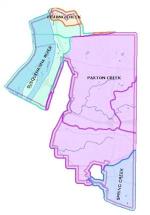Stormwater Management Program

Overview
Stormwater originates from rainfall and other precipitation that runs off of surfaces all over our community like rooftops, streets, construction sites, lawns, and fields. Stormwater makes its way across the ground picking up all types of loose materials as it travels. These items regularly found within stormwater runoff including but are not limited to; pollutants, sediment, leaves, trash, etc.
Susquehanna Township is actively involved in meeting statutory permit requirements under state and federal law. We are also active with partners in a variety of programs and strategies to enhance water quality through plantings, mowing strategies, and implementation of stormwater management facilities and other best management practices.
The Watershed Approach
How Susquehanna Township manages its stormwater is through a concept known as a watershed approach. It is no longer just about how water can be moved from point A to point B, but how the entire watershed "community" is affected by decisions made within it. Where water is directed and how its quality is impacted are the most common considerations made when land development projects are designed. Decisions made at home or within businesses play a massive role in the quality in the stormwater runoff.
A watershed is the area of land where all of the water that drains off of it goes into the same place—a river, stream or lake. The smallest watersheds are the drainage areas for small streams and lakes. Think about your local creek or river. Where does it start? What type of landscape does it flow through? Where does it end up? All of the area covered is a watershed.
Each small watershed is part of the more extensive watershed for a larger stream or river in the vicinity. There are four small watersheds in Susquehanna Township:
Paxton Creek
Spring Creek
Fishing Creek
Susquehanna River
Each small watershed is part of the more extensive watershed for a larger stream or lake in the vicinity. These larger watersheds are, in turn, part of even larger drainage networks, and so on. The largest-scale watershed is called a basin. Pennsylvania has six major watersheds. These are the drainage networks of the basin's largest rivers or lakes. Susquehanna Township is part of the Susquehanna basin. This basin covers half the land area of Pennsylvania and portions of New York and Maryland, and comprises 43% of the Chesapeake Bay’s drainage area.
Susquehanna Township's Program
From a regulatory standpoint, we have obligations to ensure that the quantity (rate and volume) of runoff is managed in addition to controlling the quality of water that is discharged. Stormwater is managed not only on private property but also on public property throughout the Township. The Township has goals identified in our NPDES MS4 Permit, where these goals must be met before the end of the permit's expiration date. Some of our goals are in the form of sediment reduction, while others are about expanding Susquehanna Township's citizens' knowledge of stormwater through education and public involvement.
Besides our own NPDES MS4 Permit, Susquehanna Township has joined forces with Capital Region Water and Lower Paxton Township for a Joint Pollution Reduction Plan. This method brings full circle the watershed approach which is the method Susquehanna Township uses for our stormwater management planning. Through a Joint Pollution Reduction Plan, Susquehanna Township, Capital Region Water, and Lower Paxton Township work together sharing sediment load reductions and costs for project implementation. For information on the proposed projects within the Joint Pollution Reduction Plan, please see file attachments at the bottom of the page!
| Attachment | Size |
|---|---|
| 268.03 KB | |
| 86.88 MB |
